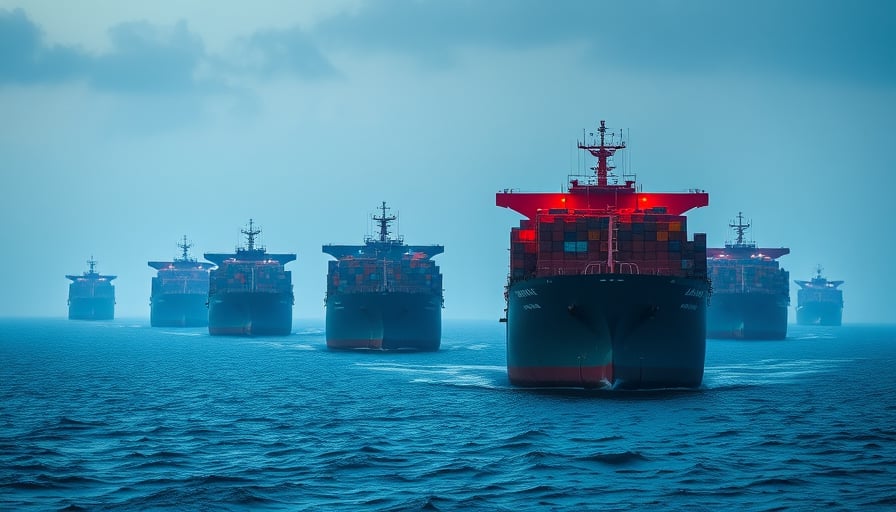Hapag‑Lloyd AG Navigates Recent Market Dynamics and Strategic Movements
The German container shipping line, Hapag‑Lloyd AG, has once again found itself at the center of industry developments, as it responds to a new wave of port‑fee policies and continues to uphold its commitment to environmental targets. While the company’s share price recently closed at EUR 118.3—well below its 52‑week high of EUR 174.6—its operational performance remains robust, supported by a full fleet utilisation and a forward‑looking outlook.
Immediate Response to China’s Retaliatory Port Fees
China’s launch of a reciprocal port‑fee program on October 14, aimed at countering U.S. measures, has immediately altered the operating landscape for global carriers. In the wake of the announcement, Hapag‑Lloyd was among the first carriers to announce “temporary changes” for two U.S.‑flagged vessels operating on Asian routes. The company’s adjustment to the TP7 rotation seeks to maintain continuity of supply chains for customers who rely on the affected service. This move reflects Hapag‑Lloyd’s proactive stance in mitigating the impact of geopolitical tensions and its readiness to adapt routing and scheduling in real time.
The port‑fee initiative, implemented in four phases, has already begun to influence freight rates and vessel deployment strategies. While container shipping companies covered by brokers are largely insulated from the initial fee impact, the broader market is expected to experience tighter vessel supply and a consequent rise in dry‑bulk and tanker rates. Hapag‑Lloyd’s swift operational adjustments position it to manage these changes with minimal disruption to its customers.
Reinforcement of Climate Commitments
Despite the turbulent market environment, Hapag‑Lloyd remains steadfast in pursuing its climate objectives. The company’s recent communications reaffirm a belief that the shipping sector can continue to progress toward net‑zero emissions even amid economic uncertainties. This stance aligns with its broader sustainability agenda, which includes investments in cleaner fuels and vessel technologies designed to reduce greenhouse‑gas intensity.
The firm’s leadership has consistently highlighted the importance of industry collaboration, particularly with peers such as Maersk, to accelerate decarbonisation efforts. By maintaining a clear focus on environmental goals, Hapag‑Lloyd seeks to preserve long‑term competitiveness while contributing to global climate targets.
Operational Resilience in a Volatile Market
A PwC Deutschland study published on October 14 revealed that 93 % of shipping companies report fully loaded fleets, and 58 % anticipate growth over the next twelve months. Hapag‑Lloyd’s performance mirrors this trend: the company continues to operate a high‑load schedule despite the macro‑economic headwinds presented by tariff increases and fluctuating freight rates. The resilience of its operational model is further underscored by its strong market capitalization of EUR 20.48 bn and a price‑earnings ratio of 8.663, suggesting a valuation that reflects confidence in its sustained profitability.
In addition to navigating immediate regulatory shifts, Hapag‑Lloyd is strategically positioned to leverage its diversified transport capabilities—encompassing sea, road, rail, and inland waterways—to offer flexible logistics solutions across global supply chains.
Market Implications and Outlook
The interplay between China’s retaliatory fees, evolving trade tensions, and the broader push for sustainability creates a complex environment for container carriers. Hapag‑Lloyd’s rapid response to route changes, coupled with its firm environmental commitments, serves as a blueprint for navigating such challenges. Analysts note that the company’s ability to maintain full fleet utilisation in the face of rising costs will likely sustain its competitive edge.
Investors monitoring Hapag‑Lloyd’s performance will find a company that balances short‑term operational adjustments with long‑term strategic planning. As the maritime industry continues to grapple with regulatory, economic, and environmental pressures, Hapag‑Lloyd’s actions illustrate a measured yet decisive approach to ensuring resilience and continued growth.
